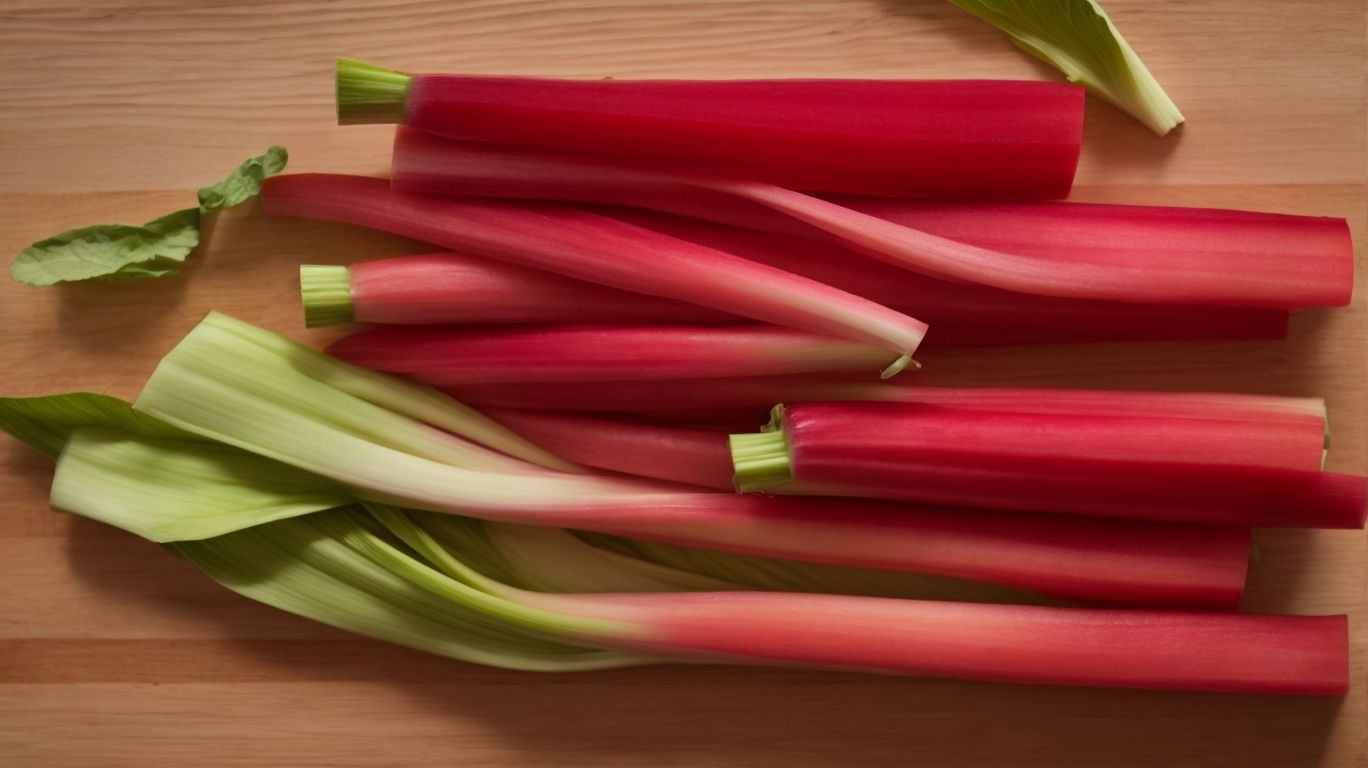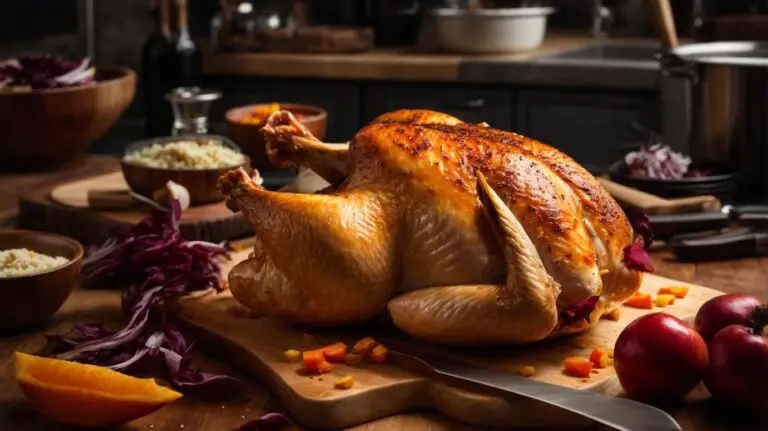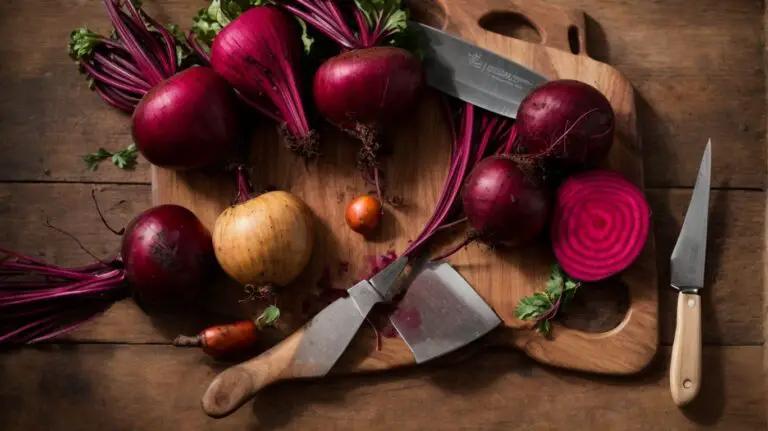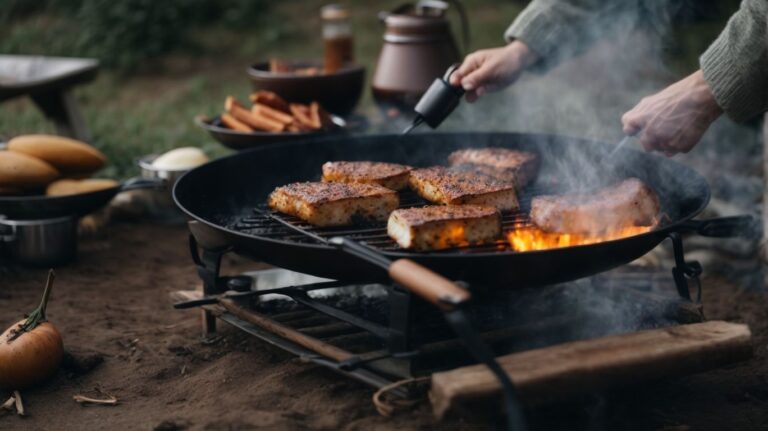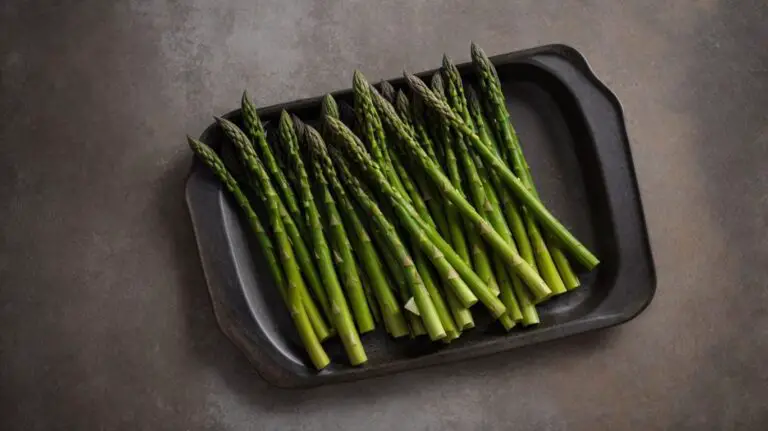How to Cook Rhubarb Without It Going Mushy?
Rhubarb, with its vibrant color and tangy flavor, is a versatile ingredient in both sweet and savory dishes. One common issue many cooks face is rhubarb turning mushy during the cooking process.
We explore why rhubarb often becomes mushy and provide tips to prevent it from happening. From choosing fresh rhubarb to using the right cooking methods, we cover everything you need to know to cook rhubarb perfectly every time.
Discover the best ways to cook rhubarb without it going mushy, including roasting, grilling, baking, and more. Elevate your rhubarb dishes to a whole new level!
Key Takeaways:
What Is Rhubarb?
Rhubarb, a perennial plant, is celebrated for its vibrant red stalks and unique tart flavor profile that adds a delightful twist to various recipes.
Its versatility extends from traditional pies and jams to contemporary cocktails and savory dishes, making it a favorite among chefs and home cooks alike. Known for its low-calorie content, rhubarb also packs a nutritional punch with high levels of fiber, vitamins K and C, and antioxidants.
Why Is Rhubarb Often Cooked Until Mushy?
Rhubarb is commonly cooked until mushy in recipes like stewed rhubarb to transform its texture and enhance its sweetness, making it a popular choice for desserts when paired with vanilla ice cream.
This process of cooking rhubarb until it reaches a soft, mushy consistency is crucial in breaking down the fibrous texture of the stalks and releasing their natural tangy flavor, usually balanced with sugar or sweeteners to create a delightful contrast of tastes.
The slow cooking method allows the rhubarb to release its juices and caramelize slightly, resulting in a rich, intense flavor profile that complements the creamy sweetness of vanilla ice cream perfectly.
What Are The Tips To Keep Rhubarb From Going Mushy?
To prevent rhubarb from becoming mushy during cooking, follow expert tips and tricks that focus on balancing its natural tartness, preserving texture, and utilizing optimal cooking techniques.
One key strategy recommended by chefs is to ensure uniform thickness when cutting rhubarb to promote even cooking. This helps maintain its firmness and structure throughout the cooking process. Incorporating a sweet component such as sugar, honey, or maple syrup can counterbalance the tartness of rhubarb, resulting in a more harmonious flavor profile.
Experimenting with different cooking methods, such as baking, stewing, or poaching, allows for versatility in preparing rhubarb while keeping its texture intact. Some experts suggest blanching rhubarb before using it in recipes to help retain its vibrant color and firmness. By following these techniques, you can enjoy rhubarb dishes that are both delectable and visually appealing.
Choose Fresh Rhubarb
Selecting fresh rhubarb from your garden or local market ensures the best quality and flavor for your culinary creations.
When you opt for fresh rhubarb, you are not only treating your taste buds to a burst of tangy sweetness but also benefiting from higher nutrient content. Fresh produce retains more vitamins and minerals compared to its store-bought counterparts. By choosing homegrown or locally sourced rhubarb, you support sustainable practices and reduce the carbon footprint associated with long-distance transportation of fruits and vegetables. Homegrown rhubarb allows you to control the growing conditions, ensuring no pesticides or harmful chemicals are used, resulting in a healthier final product.
Cut Rhubarb Into Uniform Pieces
Cutting rhubarb into uniform pieces ensures even cooking and consistent texture throughout your dish or recipe.
When rhubarb pieces are of different sizes, they will cook unevenly, leading to some pieces being mushy while others remain firm, impacting the overall mouthfeel of the dish. By maintaining consistent sizes in your rhubarb cuts, you can achieve a harmonious blend of tenderness and bite in each bite. This attention to detail elevates the visual appeal of your dish, presenting a professional and polished aesthetic to your guests or customers.
Use The Right Cooking Method
Selecting the appropriate cooking method is crucial to preserve rhubarb’s texture and flavor, whether you’re stewing, baking, or grilling it.
Stewing rhubarb helps retain its natural tanginess and create a soft, syrupy consistency that is perfect for compotes and sauces, while baking rhubarb with a sprinkle of sugar can caramelize its edges and enhance its sweet-sour balance.
On the other hand, grilling rhubarb can introduce a smoky flavor and slightly charred exterior, adding depth to its overall taste profile. Each method brings out distinct characteristics in rhubarb, so carefully considering your preferred outcome is essential when deciding how to cook this versatile ingredient.
Add Sugar To Balance The Tartness
Balancing the natural tartness of rhubarb with the right amount of sugar enhances its flavor profile and creates a harmonious blend of sweet and tangy notes.
When added in moderation, sugar acts as a key player in offsetting the sharpness of rhubarb, transforming its intense tanginess into a more palatable experience. The sweetness not only neutralizes the sourness but also adds a depth of flavor that complements the unique taste of this springtime vegetable. By striking a delicate balance between sweet and tart, the dish becomes more well-rounded and enjoyable to the palate.
Cook Rhubarb On Low Heat
Cooking rhubarb on low heat helps to gently tenderize the stalks and preserve their natural texture without turning them mushy.
By simmering rhubarb slowly on low heat, you allow the fibers in the stalks to break down gradually, resulting in a softer texture while maintaining a slight firmness that adds a delightful bite to your dish. This gentle cooking process also helps to retain the vibrant color and tangy flavor of the rhubarb, enhancing both the visual appeal and taste of your final creation. Cooking rhubarb on low heat helps to control the release of moisture, preventing the stalks from becoming overly watery.
Don’t Overcook Rhubarb
Avoiding overcooking rhubarb is essential to retain its structure and prevent it from becoming overly soft or mushy.
A common mistake many cooks make while preparing rhubarb is subjecting it to prolonged cooking times, leading to a disappointing loss of its inherent texture and vibrant color.
- Timing plays a crucial role; it is advisable to monitor the rhubarb closely during the cooking process and remove it once it reaches the desired tenderness.
Overcooking can result in a watery consistency and a lackluster appearance, jeopardizing the overall presentation of your dish.
Use Rhubarb In Recipes That Don’t Require Long Cooking Time
Utilize rhubarb in recipes that have shorter cooking times to showcase its freshness and unique flavor without compromising its texture.
When incorporating rhubarb into fast-cooking recipes, consider options like quick stir-fries, simple compotes, or even lightly grilled dishes. The advantage of shorter preparation times lies in preserving the vibrant color and enticing tartness of the rhubarb, adding a refreshing twist to any dish. These quick cooking methods not only help retain the nutritional value of the ingredient but also ensure that its crunchy texture remains intact, contributing to a delightful contrast in both sweet and savory culinary creations.
Use Rhubarb As A Topping Or Filling
Incorporate rhubarb as a delectable topping or filling in desserts to add a tangy twist and vibrant color to your culinary creations.
Rhubarb is a fantastic addition to desserts with its unique tartness that balances out the sweetness of other ingredients, creating a harmonious flavor profile. Whether used in pies, crumbles, or compotes, its distinct taste complements a variety of sweet treats. The vibrant pink and red hues of rhubarb also lend a visually appealing touch to your culinary masterpiece, making it a feast for both the taste buds and the eyes. Experimenting with rhubarb opens up endless possibilities for dessert creativity and allows you to showcase your culinary skills in new and exciting ways.
What Are The Best Ways To Cook Rhubarb Without It Going Mushy?

Credits: Poormet.Com – Jeremy Jones
Explore various cooking methods like roasting, grilling, baking, or making compote to enjoy rhubarb in diverse dishes without compromising its texture.
Rhubarb, known for its tart flavor, can be transformed into delicious treats through these different culinary techniques. When roasted, rhubarb caramelizes slightly, enhancing its natural sweetness and softening its fibers. Grilling rhubarb adds a delightful smoky flavor, which pairs well with savory or sweet dishes. Baking rhubarb allows it to soften and blend harmoniously with other ingredients in pies, crumbles, or cakes. Making compote involves simmering rhubarb with sugar, creating a versatile sauce that can be used as a topping or filling.
Roasting Rhubarb
Roasting rhubarb in the oven intensifies its flavor and preserves its texture, resulting in a caramelized and tender treat that can be enjoyed on its own or paired with savory dishes.
When rhubarb is roasted, the natural sugars caramelize, adding depth and sweetness to its tart profile. The heat of the oven transforms the rhubarb’s texture, bringing out its natural juices and creating a luxurious mouthfeel.
This process also allows for a versatile final product that can be used in various culinary applications. Roasted rhubarb can be served as a topping for yogurt, ice cream, or oatmeal, enhancing these dishes with its rich flavor and soft consistency.
Grilling Rhubarb
Grilling rhubarb imparts a smoky essence and subtle char that elevates its natural sweetness, making it a delightful addition to desserts or salads with a unique twist.
When grilling rhubarb, the heat caramelizes the natural sugars in the stalks while adding a hint of smokiness that beautifully contrasts with its tartness. To prepare, simply brush the rhubarb stalks with a light coating of olive oil, sprinkle with a touch of sea salt, and place them on a preheated grill. As they cook, the rhubarb softens, revealing a tender texture with a slightly charred exterior.
This grilled rhubarb can be used in various creative ways. In desserts, it can be chopped and mixed into a creamy panna cotta, adding a smoky-sweet dimension to the dish. Alternatively, toss grilled rhubarb slices in a vibrant salad with arugula, goat cheese, and a balsamic glaze for a unique flavor profile that will surprise and delight your taste buds.
Baking Rhubarb
Baking rhubarb in pies or baked goods transforms it into a luscious filling that perfectly balances sweetness and tartness, creating a comforting treat for any occasion.
When incorporating rhubarb into pies, it is crucial to take into account the natural tartness of the fruit. The key to achieving a harmonious flavor profile lies in the art of complementing rhubarb’s tangy notes with the right amount of sugar or honey. This not only helps to mellow out the sharpness but also enhances the overall sweetness of the dessert.
Baking techniques such as blind baking the crust before adding the rhubarb filling can prevent a soggy bottom, ensuring a crisp and flaky base that serves as the perfect foundation for the vibrant fruit filling. It’s also essential to evenly distribute the rhubarb pieces to ensure that each bite offers a burst of flavor.
Making Rhubarb Compote
Crafting a rhubarb compote allows you to capture the essence of this versatile ingredient in a sauce that can be used as a topping, spread, or accompaniment to various dishes.
When making a rhubarb compote, start by washing and chopping fresh rhubarb stalks into small pieces, ensuring to remove any tough or stringy parts. Simmer the rhubarb with sugar and a touch of water until it breaks down into a luscious, tangy mixture. The beauty of rhubarb compote lies in its ability to be adapted to suit different tastes – you can adjust the sweetness level by adding more or less sugar, or enhance the flavor with a hint of vanilla or a splash of citrus juice.
This vibrant compote can be used in a myriad of ways in the kitchen. Serve it warm over vanilla ice cream for a simple yet indulgent dessert, spread it on toast or scones for a delightful breakfast treat, or use it as a glaze for roasted meats to add a unique twist to savory dishes. The contrasting sweet-tart flavors of rhubarb compote make it a versatile addition to your culinary repertoire, offering a burst of bright flavor that complements both sweet and savory dishes alike.
Using Rhubarb In Salads
Incorporating rhubarb into salads adds a refreshing and tangy element that pairs well with vinaigrettes or seafood sauces, elevating your salad game with vibrant flavors.
Rhubarb, with its crisp texture and a slight tartness, provides a pleasing contrast to the usual salad ingredients, creating a delightful explosion of flavors in every bite.
Pairing rhubarb with a citrusy vinaigrette can enhance its natural tanginess, while combining it with a creamy seafood sauce adds a rich and savory dimension to your salad, making it a versatile ingredient for various flavor profiles.
Not only does rhubarb offer a unique taste experience, but it also brings a vibrant pop of color to your salad bowl, making it visually appealing and enticing to the palate.
Making Rhubarb Jam
Creating homemade rhubarb jam allows you to savor the essence of this nostalgic ingredient combined with sweet notes and hints of ginger for a delightful spread or topping.
When embarking on the delightful journey of making rhubarb jam, the key lies in finding the perfect balance between the tartness of the rhubarb and the sweetness of sugar. Incorporating grated fresh ginger adds a unique depth of flavor, complementing the rhubarb beautifully.
Ingredient ratios play a crucial role in achieving that perfect jam consistency. The harmony of rhubarb, sugar, and ginger needs to be carefully calibrated to ensure a jam that is not too runny or overly thick.
Simmering the mixture until it reaches the desired thickness is essential. This process allows the flavors to meld together, creating a jam that is rich, aromatic, and bursting with the essence of rhubarb and ginger.
Creating Rhubarb Chutney
Crafting a rhubarb chutney yields a savory and tangy condiment with crisp stalks that can complement cheese platters, roasted dishes, or grilled meats for a burst of flavor.
When preparing rhubarb chutney, begin by chopping fresh rhubarb into small pieces and combining them with a mixture of sugar, vinegar, and spices in a saucepan over medium heat. The slow cooking process allows the rhubarb to break down and soften, while the sweet and acidic flavors meld together to create a perfect balance.
Once the chutney reaches a thick and jam-like consistency, remove it from the heat and let it cool. The result is a vibrant condiment that offers a delightful combination of sweet, sour, and savory notes, perfect for enhancing the flavor profile of various dishes.
Frequently Asked Questions
How to Cook Rhubarb Without It Going Mushy?
1. What is the best way to cook rhubarb without it becoming mushy?
The best way to cook rhubarb without it turning to mush is by roasting it in the oven at a low temperature. This method allows the rhubarb to cook evenly and maintain its shape and texture.
2. What are some other ways to cook rhubarb without it turning mushy?
Other methods include poaching the rhubarb in a saucepan with a small amount of liquid, grilling it on a low heat setting, or even using a slow cooker. These methods also help to maintain the rhubarb’s firmness.
3. Can I freeze rhubarb without it turning mushy?
Yes, you can freeze rhubarb without it becoming mushy as long as you take the necessary steps. It’s best to freeze it in a single layer on a baking sheet before transferring it to an airtight container. This will prevent the rhubarb from clumping together and becoming mushy.
4. How do I know when my rhubarb is cooked without it turning mushy?
The key to knowing when rhubarb is cooked without becoming mushy is to watch for the color change. When it turns from a bright red to a dull green, it’s usually done. You can also test it with a fork, which should easily pierce the rhubarb without it falling apart.
5. Can I use rhubarb in recipes that call for frozen fruit without it turning mushy?
Yes, you can use rhubarb in recipes that call for frozen fruit without it becoming mushy. Just make sure to thaw it properly before using it and drain any excess liquid to prevent the rhubarb from becoming too watery.
6. Any tips for preventing rhubarb from turning mushy in a pie or tart?
When making a pie or tart with rhubarb, it’s important to add a thickener, such as cornstarch or tapioca, to the filling. This will absorb any excess liquid and prevent the rhubarb from becoming mushy. You can also pre-cook the rhubarb before adding it to the pie or tart crust.

